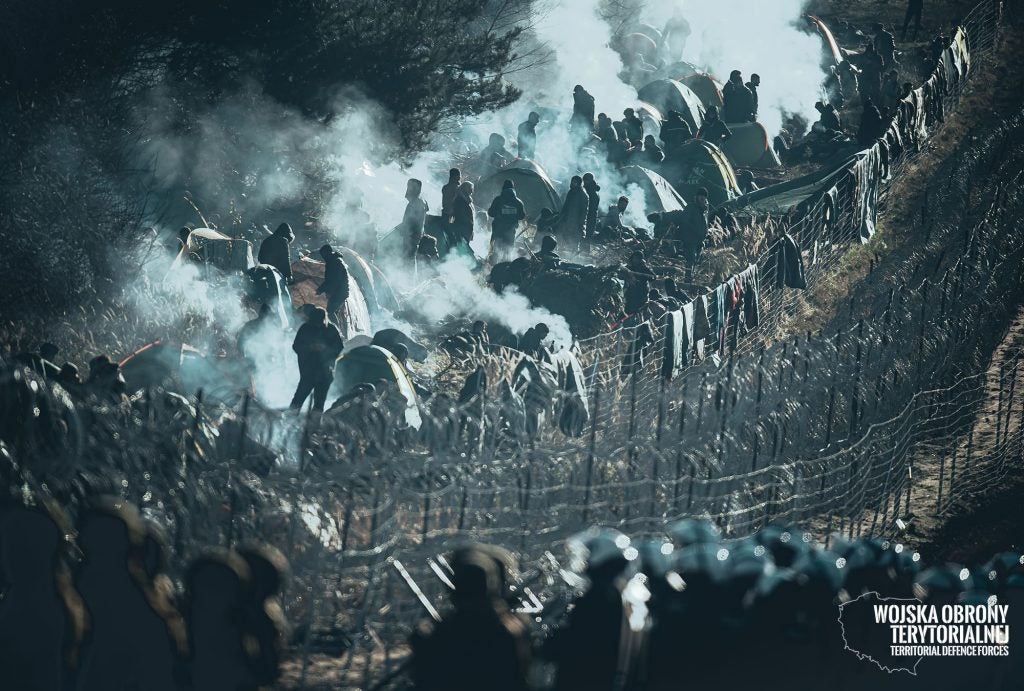Multiple Breach Attempts at Belarus-Polish Border Prevented
The situation at the Polish border with Belarus continues to deteriorate rapidly. On Monday an estimated 5,000 migrants gathered at the border in various locations. The largest group, numbering around 2,000 people set up a camp near the village of Kuznica. On Monday, 8 November, a attempt to storm a barbed wire fence, which was placed there a month before. Migrants cut down trees and used logs to tear down the obstacle and cross into Poland. A group of Polish law enforcement members, territorial defense members, and soldiers held the line and pepper-sprayed anyone who attempted to damage or destroy the fence leading to dramatic scenes.
The footage shared by the Ministry of Interior and the Ministry of National Defense show the clash between a group of migrants and Polish soldiers. The breach at Kuzniki was stopped after several hours of constant brawls and pepper-spraying the group of people trying to illegally cross the border. According to the footage provided and statements by Polish officials, Belarusian border guards assisted the illegal breach of the border by delivering wire cutters and other tools to the migrants. It has been claimed by some Polish media outlets that Belarusians disguised amongst the migrants are also damaging the border fence. Though proof of this remains elusive.
An official statement was made by the Polish officials regarding the situation at the border:
“The current situation on the Belarusian-Polish border is a result of the deliberate escalation of tension by the Belarusian side. There are large groups of migrants in the area of our border, which are fully controlled by the Belarusian security services and army. A coordinated attempt to massively enter the territory of the Republic of Poland by migrants used by Belarus for the hybrid attacks against Poland has just begun. These actions are a consequence of the form of revenge chosen by Lukashenka on Poland, Lithuania and Latvia. By creating an artificial migration route and cynically exploiting migrants, Lukashenka is trying to destabilize Poland, Lithuania and Latvia, and to force the European Union to lift the sanctions imposed on the Minsk regime. Lukashenka also wants to force the EU to give up its support for the democratic opposition in Belarus. The crisis on the Belarusian-Polish border is of political nature and was created by the state structures of Belarus against Poland. Similar hostile actions are taken against Lithuania and Latvia.”
But the escalation of the situation at the border does not stop at Kuzniki. This week several hundred illegal attempts were conducted across the entire border with Poland from the direction of Belarus. There are also circles of organized crime groups that profit from human trafficking. A week earlier a van disguised as an ambulance was stopped by the border patrol and 18 people were found inside of the vehicle. All of them were taken into custody including Polish drivers who attempted to smuggle the group to the German border.
According to the Polish Ministry of Defense, another forceful breach attempt took place on 10 November. The attempt began with the mob throwing various objects towards military and border guards. Then the group began to damage the border fence. After the arrival of reinforcements and additional police force, the situation calmed down. However, a Polish soldier at the border near Bialowieza was hit by an aggressive group at Szudzialow. He did not sustain any wounds.
Belarusian law enforcement appears to retain some control of the situation, continuing to deliver them food, water, and other supplies. New groups of migrants continue to arrive at Kuzniki and other locations. Alongside the events at the border a considerable information campaign aimed at discrediting the Polish state and portraying its violent and inhumane behavior towards the migrants.
Meanwhile, members of various Belarusian border guard units appear to be resorting to overt violence and threats to the migrants. Polish soldiers recorded several incidents while patrolling the border. In the video above a group of migrants appear to be held under weapons by the Belarusians. Suddenly a shot followed by screams and crying can be heard. This inhumane treatment increased drastically in the last few days, as well as the number of migrants on the border.
On 10 November, German chancellor, Angela Merkel called Vladimir Putin in order to resolve the situation through diplomatic means. In response, the Kremlin informed the European Union that they should talk directly with Belarus to deal with the matter. Similar remarks were made a couple of days earlier by Russian Minister of Foreign Affairs, Sergei Lavrov, who stated that the EU should pay some sort of a ransom to Belarus in order to stop the migrants influx into its borders. Meanwhile Russian nuclear-capable Backfire bombers flew over Belarus, with President Lukashenko subsequently signalling that further flights will occur.
With the weather deteriorating and temperatures falling, the fate of migrants placed at the border remains uncertain. If they do not get supplied with humanitarian aid further lives will be at stake – a number of deaths have already been reported. Yet, the Polish officials continue to be reluctant to let any of the migrants into Poland, even if they do not seek international protection here. A humanitarian crisis is at the doorstep of the EU and options to avoid it seems to be limited. The question remains what will the politicians do to prevent unnecessary deaths.
Cover picture Irek Dorozanski / DWOT
The opinions expressed in this editorial are those of the author and do not necessarily reflect the opinions or views of Overt Defense

